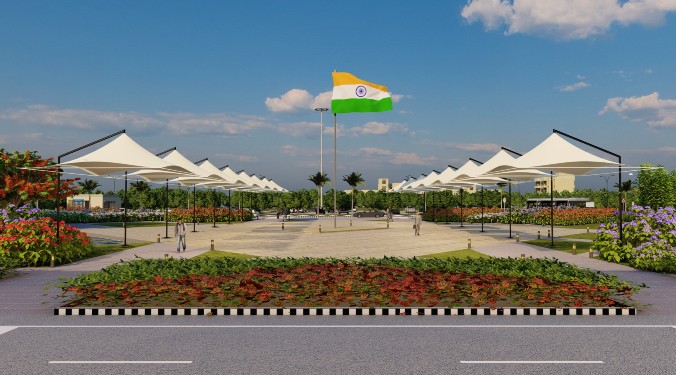“We, at TPA, are committed to the integration of environmental sustainability in our designs,” says Architect Ria Talati, Talati and Panthaky Associated Pvt. Ltd.
Sustainable architecture, which creates new ways to live and interact with the world, means putting thoughtfulness into actions. In a conversation with ACE Update, Ar. Ria Talati shares how she successfully implements the green design principles while looking at the future.
Important characteristics of green architectureGreen architecture is not only sustainable but innovative too. The boundaries of architecture need to be pushed with the new consciousness and awareness we now have about the impact we make on our environment. Sustainable architecture, which is a preferred phrase, will create new ways to live and interact with the world as this awareness grows. It needs to be a mindset.
This future of architecture needs to be a holistic solution, creating minimum impact while leaving the smallest footprint possible on our world both socially and environmentally. This needs to start from the beginning with building and construction methods (to consider both the environment and interests/safety of the labour) to appropriate material selections that have limited carbon footprints and are locally appropriate. A building is a living breathing entity, and reducing its consumption imprint of resources like water, electricity and energy through its entire life cycle is the ultimate goal.
Achieving sustainability in architectureSustainability in architecture can only be achieved once the mindset of the developers and architects changes and also with support and incentives from the government. One is not possible without the other. Once this is achieved to be truly sustainable, the project has to be looked at as a whole from inception to time after it has been occupied.
Green design is not just a catchphrase, but a belief and an outlook. As an architect, implementing the principles of green design or sustainable design means putting thoughtfulness into actions, conscientiously considering the built environment and reversing the havoc we have inflicted on our resources while looking to the future.
Sustainability can only be achieved by commitment and conviction on all fronts and by making sure the entire life cycle of a building is thought through.
Green roofs and IndiaGreen roofs are a relatively newly developing movement in architecture in India. It makes a lot of sense (both environmentally and commercially) to create green roofs in India, especially in urban areas like Mumbai where open space is at a premium. In Mumbai it is 1.1 square metres a person, less than even Mexico City and Tokyo.
It can also help manage storm water and moderate the heat intensity we suffer due to our environment.
India has opened up considerably in the fields of design, architecture and construction in the last few years with the immense international exposure and interest that has befallen the country. The possibilities are now limitless and this new exposure can now be used to its maximum with a little bit of imagination and innovation, and many architects are adopting green roofs and sustainable design as a way to make buildings more efficient and ecological as well as improve the quality of our urban experience.
As far as green roofs go, one cannot be considered “green” by solely installing a rooftop garden. For example, if it has materials air lifted from China and poorly insulated windows, its poor use of resources would suggest it’s really not that “green” at all.LEED provides little roomThere has been a lot of concern about stated energy use versus actually energy with LEED certifications. But there is no way to accurately predict a building’s energy use if it hasn’t been built — that’s why LEED relies on energy models. If an owner changes the hours of the building operation, the energy use goes up. It is very difficult to be accurate.
LEED started as a system by people who wanted to establish green building as a viable promising market. So they came up with a business-savvy strategy where buildings could be environmentally conscientious and also increase efficiency and decrease cost. It initially made a lot of businesses clamour for its long-term cost-saving and PR potential.
But LEED provides very little room to recognise design that goes beyond the scope of its categories. It works well for those looking to check boxes as well as for those genuinely concerned about the environment. Even though the accreditation can be seen as a status symbol, it does also encourage people to make environmentally conscious decisions to get the certification.
As part of a huge bureaucratic structure that takes years to update, LEED cannot help but be perennially stuck in the past. Hopefully, it will improve its bureaucratic complexity and cost and encourage a more nuanced understanding of context, and – critically – allow more room for innovation that will lead us into the future.
Green designs and Talati and Panthaky AssociatedGreen building is the undeniable future in every urban area — not only in this country but all over the world. Architects should be sensitive to not only the latest trends in sustainable design such as solar panels or green roofing but also need to be acutely aware of our unique Indian climate, lifestyle and the local materials. Context is very important. For decades, TPA has been pulling in its fenestration to provide flowerbeds. This is not only for the beauty of the building but also to practically reduce the suns intensity and therefore keeping the interiors cooler and consequently reducing the air-conditioning requirements. Its project Palais Royale is on track to being the first LEED Platinum certified residential building in the world, and TPA is committed to the integration of environmental sustainability in its designs.
8
Cookie Consent
We use cookies to personalize your experience. By continuing to visit this website you agree to our Terms & Conditions, Privacy Policy and Cookie Policy.









